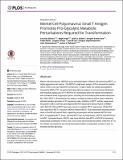| dc.contributor.author | Berrios, Christian | |
| dc.contributor.author | Padi, Megha | |
| dc.contributor.author | Park, Donglim Esther | |
| dc.contributor.author | Molla, Vadim | |
| dc.contributor.author | Cheng, Jingwei | |
| dc.contributor.author | Lee, Soo Mi | |
| dc.contributor.author | Stephanopoulos, Gregory | |
| dc.contributor.author | Quackenbush, John | |
| dc.contributor.author | DeCaprio, James A. | |
| dc.contributor.author | Keibler, Mark Andrew | |
| dc.date.accessioned | 2017-04-06T19:12:50Z | |
| dc.date.available | 2017-04-06T19:12:50Z | |
| dc.date.issued | 2016-11 | |
| dc.date.submitted | 2016-04 | |
| dc.identifier.issn | 1553-7374 | |
| dc.identifier.uri | http://hdl.handle.net/1721.1/107910 | |
| dc.description.abstract | An accurate analytic model describing the microscopic mechanism of high-harmonic generation (HHG) in solids is derived. Extensive first-principles simulations within a time-dependent density-functional framework corroborate the conclusions of the model. Our results reveal that (i) the emitted HHG spectra are highly anisotropic and laser-polarization dependent even for cubic crystals; (ii) the harmonic emission is enhanced by the inhomogeneity of the electron-nuclei potential; the yield is increased for heavier atoms; and (iii) the cutoff photon energy is driver-wavelength independent. Moreover, we show that it is possible to predict the laser polarization for optimal HHG in bulk crystals solely from the knowledge of their electronic band structure. Our results pave the way to better control and optimize HHG in solids by engineering their band structure. | en_US |
| dc.language.iso | en_US | |
| dc.publisher | Public Library of Science | en_US |
| dc.relation.isversionof | http://dx.doi.org/10.1371/journal.ppat.1006020 | en_US |
| dc.rights | Creative Commons Attribution 4.0 International License | en_US |
| dc.rights.uri | http://creativecommons.org/licenses/by/4.0/ | en_US |
| dc.source | PLoS | en_US |
| dc.title | Merkel Cell Polyomavirus Small T Antigen Promotes Pro-Glycolytic Metabolic Perturbations Required for Transformation | en_US |
| dc.type | Article | en_US |
| dc.identifier.citation | Berrios, Christian et al. “Merkel Cell Polyomavirus Small T Antigen Promotes Pro-Glycolytic Metabolic Perturbations Required for Transformation.” Ed. Robert F. Kalejta. PLOS Pathogens 12.11 (2016): e1006020. | en_US |
| dc.contributor.department | Massachusetts Institute of Technology. Department of Chemical Engineering | en_US |
| dc.contributor.mitauthor | Keibler, Mark Andrew | |
| dc.relation.journal | PLOS Pathogens | en_US |
| dc.eprint.version | Final published version | en_US |
| dc.type.uri | http://purl.org/eprint/type/JournalArticle | en_US |
| eprint.status | http://purl.org/eprint/status/PeerReviewed | en_US |
| dspace.orderedauthors | Berrios, Christian; Padi, Megha; Keibler, Mark A.; Park, Donglim Esther; Molla, Vadim; Cheng, Jingwei; Lee, Soo Mi; Stephanopoulos, Gregory; Quackenbush, John; DeCaprio, James A. | en_US |
| dspace.embargo.terms | N | en_US |
| dc.identifier.orcid | https://orcid.org/0000-0002-5410-6543 | |
| mit.license | PUBLISHER_CC | en_US |
